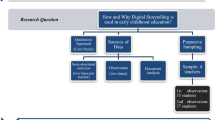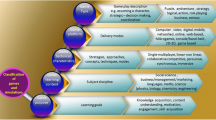Abstract
The history of the Indonesian state began to be forgotten by its young generation. Today’s young generation or so-called “millennial” rarely studies history pursued by previous state fighters. One of the histories of the Indonesian state is the story of Prince Kian Santang. The lesson that taken from the story of Prince Kian Santang is the wise character of Prince Kian Santang, which used as an example for Indonesian people who are facing the current era of globalisation. Prince Kian Santang is not trapped in such a position and is more concerned with society and community rights. Through Digital Storytelling and educational games, researchers hope that Indonesian teens will not forget the Prince Kian Santang story. Using the ADDIE methodology, researchers designed the game “Prince Kian Santang” and got satisfactory results.




Similar content being viewed by others
References
Bakan, U., & Bakan, U. (2018). Game-based learning studies in education journals: A systematic review of recent trends. Actualidades Pedagógicas, 72, 119–145.
Barros, L.M., & Musse, S.R. (2008). Towards consistency in interactive storytelling: tension arcs and dead-ends. Computers in Entertainment, 6, 1–17.
Branch, R.M. (2009). Instructional design: The ADDIE approach. New York: Springer.
Gee, J. (2003). What video games have to teach us about learning and literacy. New York: Longman.
Goyal, S. (2012). E-Learning: Future Of education. Journal of Education and Learning, 6, 239–242.
Hilal, A., Ehab, F.A., & Amjad, S. (2015). The effectiveness of multimedia learning tools in education. International of Advanced Research in Computer Science and Software Engineering, 5, 761–764.
Honey, P., & Mumford, A. (1992). The manual of learning styles. Maidenhead: Peter Honey.
Jiwak, R.B. (2016). Strength of traditional and social media in education: A review of the literature. IOSR-JRME, 6, 13–21.
Lambert, J. (2006). Digital storytelling: Capturing lives, creating community digital. Berkeley: Diner Press.
Miller, C.H. (2008). Digital storytelling, second edition: A creator’s guide to interactive entertainment. United Kingdom: Focal Press.
Nader, B., Shahrooz, F., & Nahid, H. (2012). The effect of teaching model based on multimedia and network on the student learning (case study: Guidance schools in Iran). Proceedia – Social and Behavioral Sciences, 47, 1263–1267.
Purwanto, B. (2019). Perspektif historis kesadaran kebangsaan dan kemerdekaan Indonesia berdimensi kebudayaan. HISTORIA: Jurnal Pendidik dan Peneliti Sejarah dan Sejarah, 2(2), 125–133.
Raessens, J., & Goldstein, J. (2005). Computer games and learning: Digital Game-Based learning: Handbook of computer game studies. cambridge: The MIT Press.
Rahmat, R.F., Harry, Syahputra, M.F., Sitompul, O.S., & Nababan, E.B. (2017). The depth-first search column by column approach on the game of babylon tower, Second International Conference on Informatics and Computing (ICIC), 1–6.
Rapeepisarn, K., Wong, K.W., Fung, C.C., & Khine, M.S. (2008). The relationship between game genres, learning techniques, and learning styles in educational computer games. In Pan, Z., & Rouse, R. III (2004) (Eds.) Design theory and practice. 2nd edn. Massachusetts: Jones & Barlett Learning.
Rouse, R. III. (2004). Game Design Theory And Practice, 2nd edn. Massachusetts: Jones&Barlett Learning.
Thue, D., Bulitko, V., Spetch, M., & Wasylishen, E. (2007). Interactive storytelling: a player modeling approach. In Proceedings of the 3rd, Artificial Intelligence for Interactive Digital Entertainment Conference (AIIDE ’07) (pp. 43–48).
Zagal, J.P., Mateas, M., Fernández-Vara, C., Hochhalter, B., & Lichti, N. (2005). Towards an ontological language for game analysis. In Proceedings of the diGRA Conference: Changing Views—Worlds in Pla (diGRA ’05).
Author information
Authors and Affiliations
Corresponding author
Additional information
Publisher’s note
Springer Nature remains neutral with regard to jurisdictional claims in published maps and institutional affiliations.
Rights and permissions
About this article
Cite this article
Tanjung, M.A.P., Sitompul, O.S. “Kian Santang” game as historical educational media using digital storytelling concept. Educ Inf Technol 25, 5379–5388 (2020). https://doi.org/10.1007/s10639-020-10209-0
Received:
Accepted:
Published:
Issue Date:
DOI: https://doi.org/10.1007/s10639-020-10209-0




